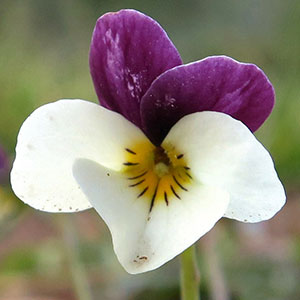Viola hallii
Viola canina
Hall's violet, Oregon violet, wild pansy
dog violet, heath dog-violet
1–3, decumbent or ascending to erect, ca. 1/2 subterranean, glabrous, clustered on single, short, vertical, deep-seated caudex.
1–5, ascending to erect, glabrous, on caudex from subligneous rhizome.
basal and cauline;
basal: 1–4, palmately compound, ± 2-ternate or 3-ternate, leaflets 3;
stipules adnate to petiole, forming 2 linear-lanceolate wings, unlobed, margins entire, apex of each wing free, acute;
petiole 5–8 cm, glabrous;
blade ovate to deltate, 2.8–6 × 2.6–6.5 cm, ± coriaceous, base tapered, ultimate lobes narrowly elliptic, lanceolate, or oblanceolate, 1–7 mm wide, margins entire, ciliate or eciliate, apex acute, mucronulate, surfaces glabrous;
cauline similar to basal except: stipules usually lanceolate, sometimes broadly ovate, ± leaflike, margins toothed;
petiole 1.3–6 cm;
blade 2–4.8 × 1.2–5.5 cm.
cauline;
stipules linear to lanceolate, margins ± lacerate to subentire, points often gland-tipped, apex acute;
petiole 0.3–2.5 cm, glabrous;
blade ovate to narrowly ovate, 1.2–5.2 × 1–2.7 cm, base cordate or deeply cordate to truncate, margins crenate, eciliate, apex acute to obtuse, abaxial surface glabrous or sparsely pubescent on veins, adaxial surface glabrous or sparsely pubescent.
2.5–11 cm, glabrous.
1–10 cm, glabrous or sparsely puberulent.
sepals lanceolate to ovate, margins ciliate, auricles 0.5–1 mm;
petals: upper 2 almost black abaxially, dark reddish violet adaxially, lower 3 pale yellow, cream, or ± white, lateral 2 bearded, with deep yellow to orange patch basally, dark reddish violet-veined, lowest with deep yellow to orange patch basally, dark reddish violet-veined, 5–18 mm, spur yellow, gibbous, 0.5–2 mm;
style head bearded; cleistogamous flowers absent.
sepals lanceolate, margins eciliate, auricles 2–3 mm;
petals usually blue- to gray-violet on both surfaces, rarely white, white basally, lower 3 dark violet-veined, lateral 2 bearded, lowest 15–25 mm, spur light yellow to light green or white, gibbous to usually elongated, 3–5 mm;
style head beardless; cleistogamous flowers axillary.
ellipsoid, 4–12 mm, glabrous.
ovoid, 7.5–9 mm, glabrous.
light brown, shiny, 3.2–3.5 mm.
light to dark brown; 1.7–2.1 mm.
= 60, 72.
= 40.
Viola hallii
Viola canina
Viola hallii was discovered on the grounds of Willamette University in Salem, Oregon, by Elihu Hall, a professor at that institution (V. B. Baird 1942). Leaves of V. hallii are similar to V. beckwithii.
(Discussion copyrighted by Flora of North America; reprinted with permission.)
Viola canina was possibly introduced in Greenland (T. Marcussen and T. Karlsson et al. 2010).
Hybrids of Viola canina are known with the European species V. mirabilis Linnaeus, V. pumila Chaix, V. reichenbachiana Jordan ex Boreau, V. riviniana Reichenbach, V. rupestris F. W. Schmidt (both subspecies), V. stagnina Kitaibel, and V. uliginosa Besser.
(Discussion copyrighted by Flora of North America; reprinted with permission.)


